I first heard about the San Francisco 24-hour ultrarunning challenge several years ago when my friend Jennifer O’Connor signed up. A bunch of runners go in one-mile loops around Crissy Field, in San Francisco near the base of the Golden Gate Bridge, over and over again without changing direction for an entire day.
Showing up in the middle of the night to support her, I encountered ghost-like runners methodically moving through thick fog with downcast expressions, as if fulfilling a sentence for a crime. The scene looked like a 20th-century psychological experiment from the Eastern bloc that should be banned in modern times. I thought I could never do it, nor would I want to.
Then, two-and-a-half years ago, I returned to the New Year’s Eve version of this 24-hour event to support 71-year-old Eldrith Gosney at it (see post). By that time, my interest and experience in ultrarunning had developed, and I could glimpse the appeal of the physical and mental challenge. Also, while hanging out at the aid station, I saw the high degree of camaraderie that goes with the event.
But I still didn’t think I’d want to try it . I’m a trail runner—I like dirt, rocks, hills and varied natural scenery. I want to run up a mountain, not around a rectangle like this:
So why did I end up doing the Summer Solstice 24-hour run? Ultimately, to see if I could. Could I go for 24 hours without stopping (except to change clothes, eat and go to the bathroom)? How would I do as an ultrarunner when the variables of terrain and elevation are taken away and it’s just about running?
On a more practical level, I signed up because I wanted an ultra challenge that fit with my family’s summer schedule. This was logistically easy and family-friendly. Having my family come out to support me like they did at this event was the best thing ever!
I parked at Crissy Field at 6:15 a.m. Saturday morning, June 20, one of the first runners to arrive so that I could stake out a prime parking spot and location for my little table that held a gear bag, a cooler with food, and a duffel with layers of clothing for the cold and windy nighttime. Then I sat in my car, rested and mentally prepared for the challenge until the 8 a.m. start.
Nearly 24 hours later, I finished my final lap. I completed 109 laps of 1.061 miles each, which added up to 115.6 miles, with an average pace of 12:23/mile. I fell short of my goal of 120 miles (a 12-minute/mile average pace) but surpassed my secondary goal of going over 100 miles and, most importantly, NOT QUITTING.
My time was good enough for the women’s win and 7th overall. Two seasoned female ultrarunners, both in my age group, posed a challenge, but both stopped early—Stacey Costa, who dropped due to knee trouble; and Brenda Blinn, who stopped after “only” 80 miles because she has Tahoe Rim Trail 100 next month.
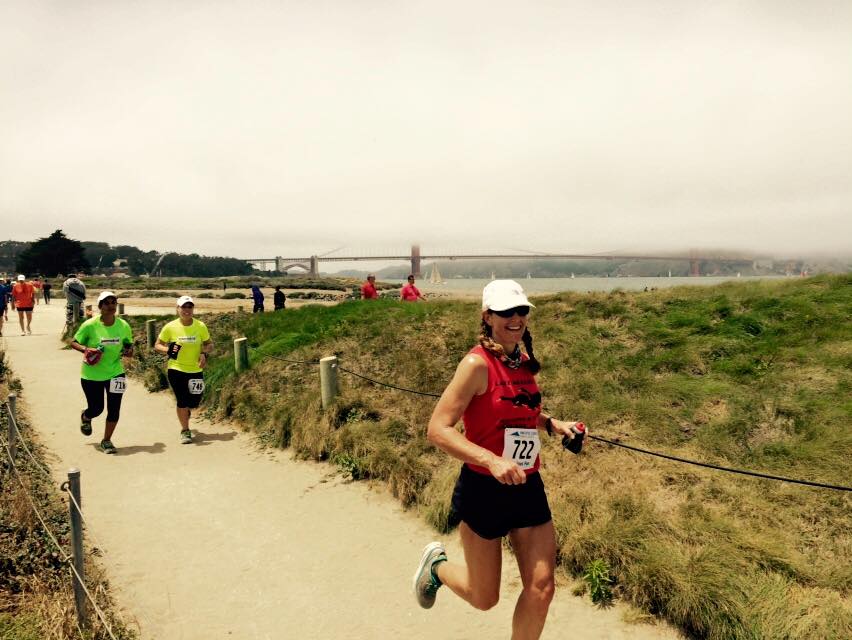
Sometime during the first 12 hours, Jesse Jay Jimenez snapped this shot of me cruising along the promenade portion of the course. Thanks, Jesse! Fog obscured the bridge for much of the day, with a cold wind blowing the fog in and out.
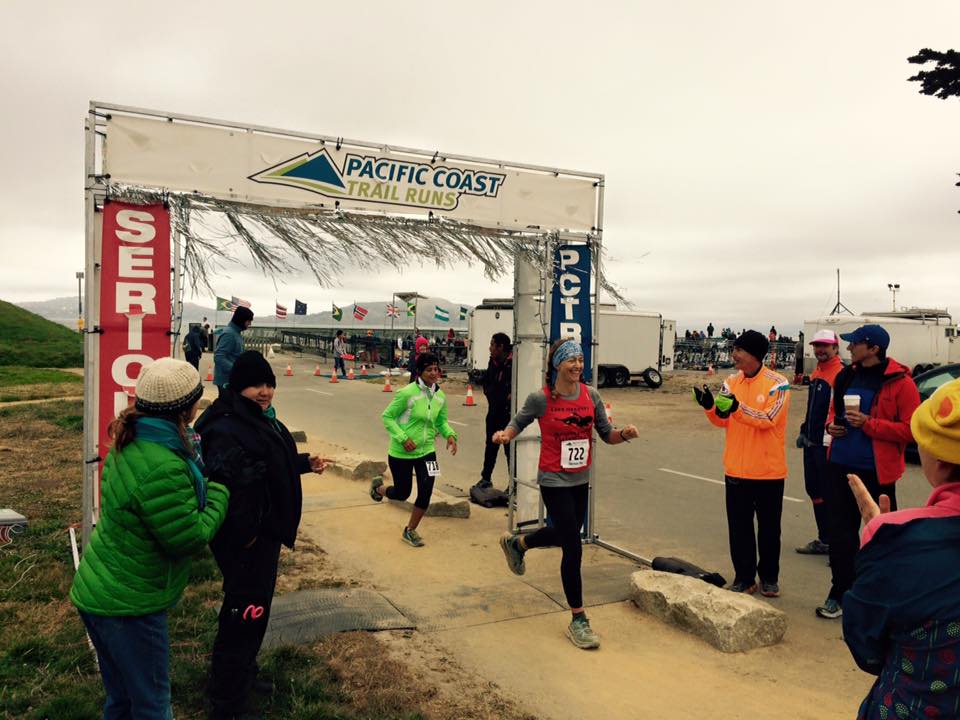
23 hours, 52 minutes after the start, I finished my last loop. Thanks again to Jesse for getting this shot. That’s his wife Jenni behind me. See how everyone was dressed? It was cold!
I do not pretend to be an expert at 24-hour timed ultrarunning events now, but I did learn a few things. Here are 10 of them.
1. Get flat and loopy with your training and incorporate deliberate walking breaks.
I deviated from the trails and hit long, mostly flat and mostly paved stretches for training runs. I also did lots of loops around Oakland’s Lake Merritt and Lake Temescal. On long runs, I’d try run/walk intervals of 8 minutes running, 2 minutes walking to practice brisk walking and get used to transitioning from walking back to running. Also, during the walking breaks, I’d practice talking long strides to stretch out my calves, sideways “grapevines” to stretch out my hips and torso, and windmilling my arms to loosen up my upper body.
I also started walking more later in the day, such as taking after-dinner walks or walking home from a restaurant when we went out to eat, in order to adapt to more time on my feet.
Other than that, my training stayed pretty much the same, with some form of speedwork once a week and hard hills on another day, along with strength conditioning two to three times a week. I peaked with a 77-mile week followed by an 80-mile week five to six weeks before the event, and then late May and early June were so busy that I couldn’t run as much. In the final weeks before the event, I concentrated on staying healthy, preparing mentally, trying to lose a couple of pounds (since my weight was at the high end of its range) and most importantly, getting lots of sleep!
2. It helps to break your 24-hour plan into fractions.
I thought of this event in quarters—6 hours each—and made a plan for each quarter. My strategy was to run the first 6 hours solidly at a very conservative, steady pace of around 9:30/mile. I ran a bit faster than that, but bathroom breaks made the average pace slower. In the afternoon, I started walking the short ends of the rectangle. I also started concentrating on the laps in segments of 10; e.g. “just get to 60.” I vowed not to think of the entire night ahead. After 8 p.m., I added a walking break along the paved long end of the course. After 2 a.m.—the final quarter—I vowed simply to keep going lap by lap, one foot in front of the other.
I started the event with a very specific pacing plan for each quarter, which helped calm my nerves and feel prepared at the start. But, the reality is that the event plays out like giving birth, when your thoughtful “labor and delivery plan” goes out the window and you do whatever works to get through it.
3. Balanced, relaxed form is more important than ever.
Every time the eventual male winner, Chikara Omine, lapped me, he looked so balanced and relaxed through his upper body, and I would try to emulate him. (Chikara set a course record with 132 miles.) He and other top runners tended to take short, quick strides and maintained good posture and a strong yet relaxed arm swing. I concentrated on keeping my form symmetrical, my feet parallel (which is hard because of my natural turnout), my knees slightly bent to prevent over-striding, and my turnover smooth as if pedaling a bike.
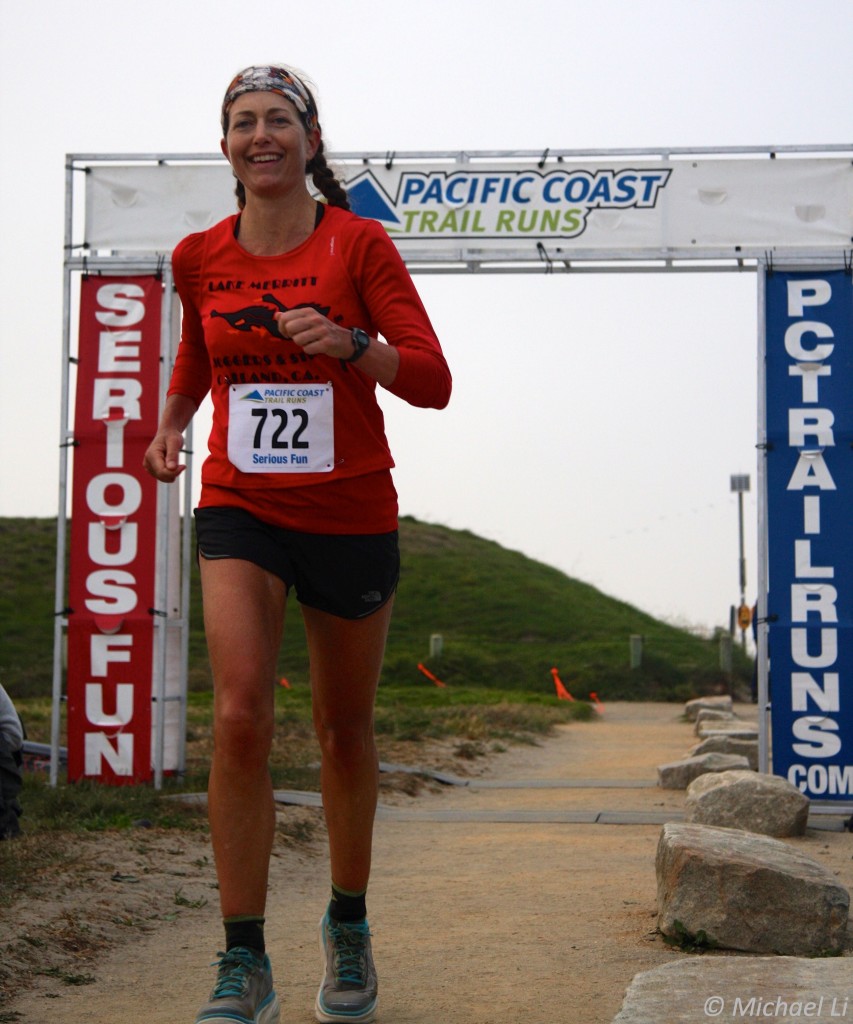
Michael Li took this pic sometime in the late afternoon. I tried really hard to keep my upper body upright and relaxed, legs and feet parallel (since my right side tends to fling out), and knees always slightly bent to prevent over-striding.
4. Even with good form, your feet and legs will become temporarily f***’ed up, especially your “inside” side.
My lower body is truly trashed and I’m sore all over. I have never had such swollen, painful ankles. Blisters, bruises and a strange rash covered both feet and ankles. But my right foot hurt twice as badly afterward, with an Achilles tendon so tight I can barely put weight on it.
I wondered why my right foot was in so much more pain, given how hard I worked to run with balanced form. Then it hit me: I made 436 sharp right-hand turns! The pivoting action to go around the corners of that rectangle really tweaked that side.
5. You can lose a lot of time at the potty and aid station.
I swear to God I could have hit my goal of 120 miles if I didn’t have to crap and pee so much. Unlike at a regular trail race where you can discreetly and efficiently pee by the side of the trail, here you have to walk a little ways off course to use the portapotty. Initially I tried to limit my bathroom breaks to once every 10 laps, but after a while, all the food I ate was going straight through me and I had to make a pit stop more frequently.
I also probably spent more time than I should have pausing at my little table of gear, which was right across from the aid station. In a regular ultra, an aid station is located about every four to seven miles. Here, it’s every mile! Runners may be tempted to stop, talk and overeat on each lap.
I tried to limit my pauses at the gear table to only once every three laps. In the second half, it became every other lap. I enjoyed the freedom of running without a hydration pack filled with stuff, so I stopped more frequently to get a gel, food or drink refill than I would have if I had been running with a hydration pack and full pockets.
The only thing I carried most of the time was my Ultimate Direction Handy 10, which was the perfect size and weight.
6. Leave your Garmin at home and wear a simple stopwatch instead.
I’ve noticed before at the track that my Garmin does not accurately measure a 400-meter loop. The same was true for this larger loop. I started the event wearing the Garmin to get a sense of pace, but then I realized it was over-estimating the distance of each loop so the pace it displayed wasn’t accurate either. It’s better to wear a simple stopwatch and do the math in your head, and then you also don’t have to worry about your Garmin’s battery dying. Also, the event’s clock displayed our lap splits, so I could see each lap how I did.
7. Staying awake all night is harder than at a regular ultra.
I really underestimated how difficult it would be to stay awake. I never before had a problem staying awake to run all night, but that’s because on those other occasions I was running a trail and my mind had to stay sharp to look where I was going.
Here, the repetition and the foggy atmosphere proved soporific. I could barely keep my eyelids up and fantasized about lying on the ground to nap. The bushes along the lagoon turned into hallucinations of abstract sculptures and zoo animals (one hippo, one bear is all I can recall now). The high-caffeine GU gels had limited effect. Thank goodness I slept well every night during the prior week, letting myself sleep in to get a full eight to nine hours each of the five nights before the event.
Several participants set up tents by the aid station for short nap breaks. I decided not to take a tent and not to drive my campervan to the event because it would be too tempting to sleep. I was right and am glad I just drove our less-comfy Subaru and parked it out of view!
8. Going past the 100-mile mark is hard—and part of the challenge.
Several people stopped when they hit 100 miles. They ran 100 and met their goal—good for them! But, it was only around 6 or 7 a.m.—22 to 23 hours into it—when they stopped. Dude, you have more time for more laps! Keep at it! It’s a 24-hour challenge, not a 100-mile challenge!
I almost stopped prematurely, too. My Achilles became so tight and knee so wonky that I stopped running and walked the last few loops, which took around 20 minutes per loop. I embarked on what I thought would be my final loop just after 7:20 a.m., figuring I’d cross the finish line after 7:40 and finally be DONE because there wouldn’t be time for another lap.
Halfway around, I vowed to finish strong and mustered the fortitude to start running again. In the final turn, when I saw the crowd, I surged to what felt like a sprint and crossed the finish with fists raised above my head for a triumphant finish line photo. I did it!
Everyone looked at me like something was wrong, and my friend Cheryl said, “You have time for one more! Go, go!”
I looked at my watch. It was about 7:35 a.m.—25 minutes still remaining—so they were right. “Fuuuu…..” I started to wail, then said “OK!” and kept running—running almost the whole final lap in under 13 minutes. It’s thanks to them I made it to 115 miles (109 laps) for the total.
9. You need to start with a goal and an unwavering commitment.
This is not an event to do “just for fun” or “just as a training run” (unless, like Brenda, you have a specific mileage goal to reach before stopping for training purposes). A casual or ambivalent attitude will quickly give way to a DNF as all those laps seem pointless. Develop a goal and commit not to quit.
10. It’s actually not boring.
I surprisingly had the best day out there! I loved being away from my phone, having just one job to do, and observing the day in the life of a place.
The fog rolled in and out; boats set sail, kites flew. Families strolled by, couples argued or kissed, cyclists yelled “out of my way!” Dogs of almost every size and breed scampered on the beach. The lights on the bridge came on after dark; massive cruise ships with all their windows aglow silently floated past. Raccoons and rats scurried to trash cans. There was so much to see, and so much going on, which made every lap truly unique.
The other runners became fascinating character studies as well. I looked forward to seeing them—and observing how they had changed their gait, changed their clothes, changed their expression or tone of voice—as we passed each other throughout the day and night.
I want to publicly thank John and Maureen Brooks, race directors at Pacific Coast Trail Runs, for putting on a very well-organized and positive event. Kudos to John and Maureen for remaking PCTR into a strong and dependable race organization. Note: this timed challenge has 6-, 12- and 24-hour divisions, and it takes place both on Summer Solstice by PCTR and on New Year’s Eve by Coastal Trail Runs.
I also want to thank friends who came to support me, especially Cheryl Kovalchik who was there from 4:30 a.m. until the finish, and my pregnant niece Siobhan and her husband Miguel who made a special trip out and helped me change into warmer clothes. Jeff Lang, Cabot Brown and others who made a special trip out to cheer me on really boosted my spirits. The volunteers and friends/crew who hung out by the sidelines were awesome (Jesse, Leigh-Ann, Janeth, Erika, Chris, Laura, Jen … sorry, I know I’m forgetting lots…). Special thanks to Michael Li and Jesse Jay Jimenez for taking photos and sharing them.
Misc. Notes on Life and What’s Next
I let this blog go dormant for nearly two months because I was too busy with coaching, writing for Trail Runner magazine and handling commitments for the Thacher School board (the school where Morgan and I both went and our kids now go—Kyle starts there this fall in 9th grade and Colly will be a senior).
I crisscrossed California twice in two weeks (Piedmont > Ojai > Palm Springs > Ojai > Piedmont > Ojai > Piedmont) to move my daughter Colly out of school and go on a little road trip with her to P.S., then returned to Piedmont for Kyle’s 8th grade graduation, then back to Ojai to Morgan’s 30th reunion at Thacher. On our way back home from Southern California the final time, we stopped to camp and hike at Pinnacles National Park (blog post on Pinnacles coming soon!). All in all, it’s been a great kickoff to summer.
Soon we leave for Telluride, Colorado, for the month of July, where I’ll be a pacer at Hardrock for Clare Abram and then do the 12-mile Kendall Mountain “Skyrunning” race in Silverton the following weekend.
Here are some photos from the past few weeks:
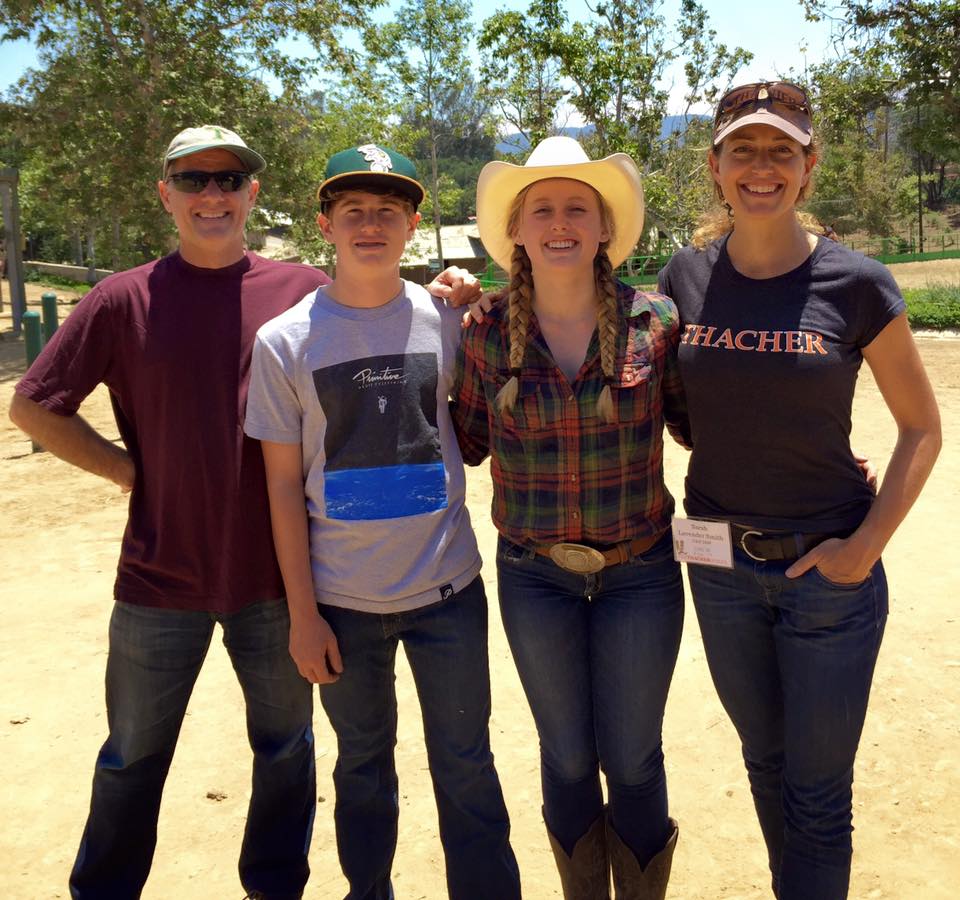
Our family at Thacher School for Morgan’s 30th reunion (mine is next year).


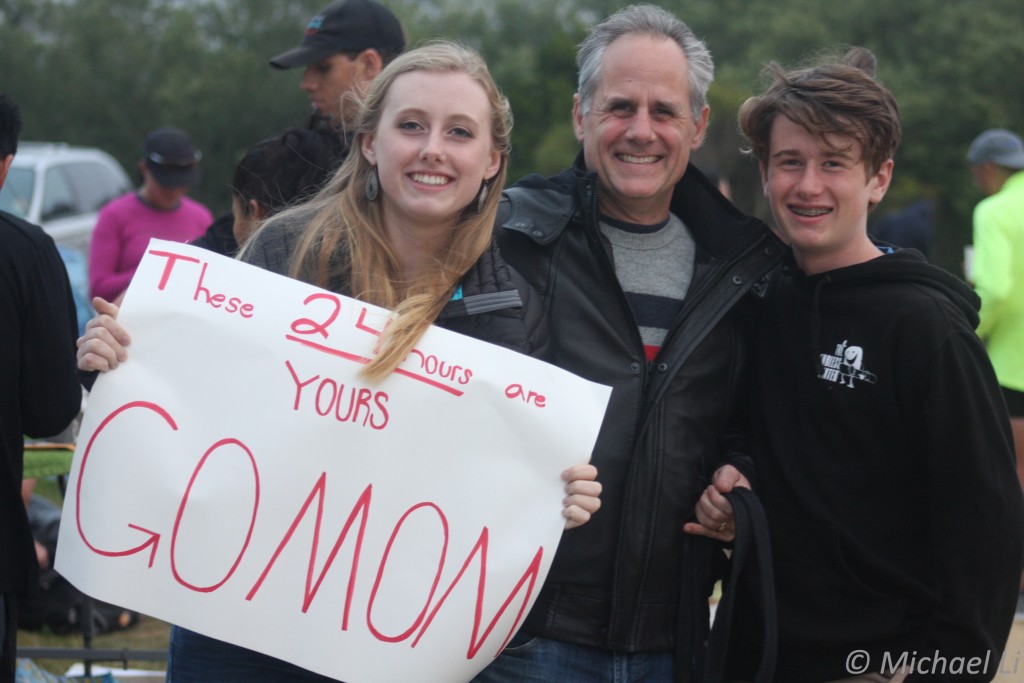
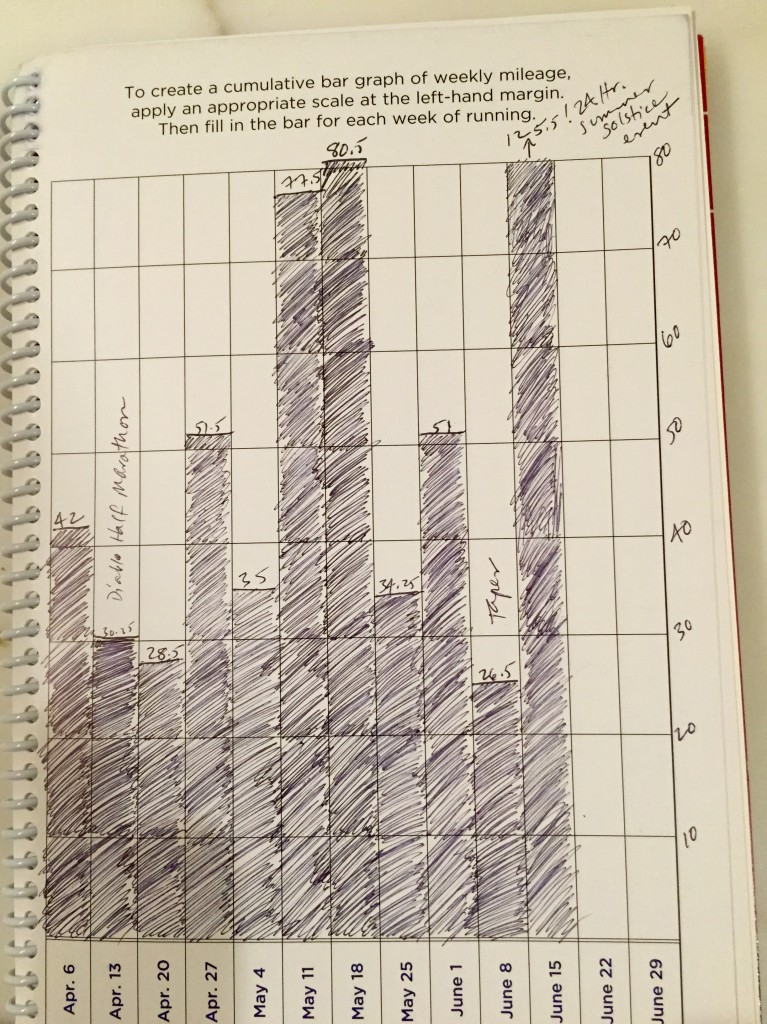
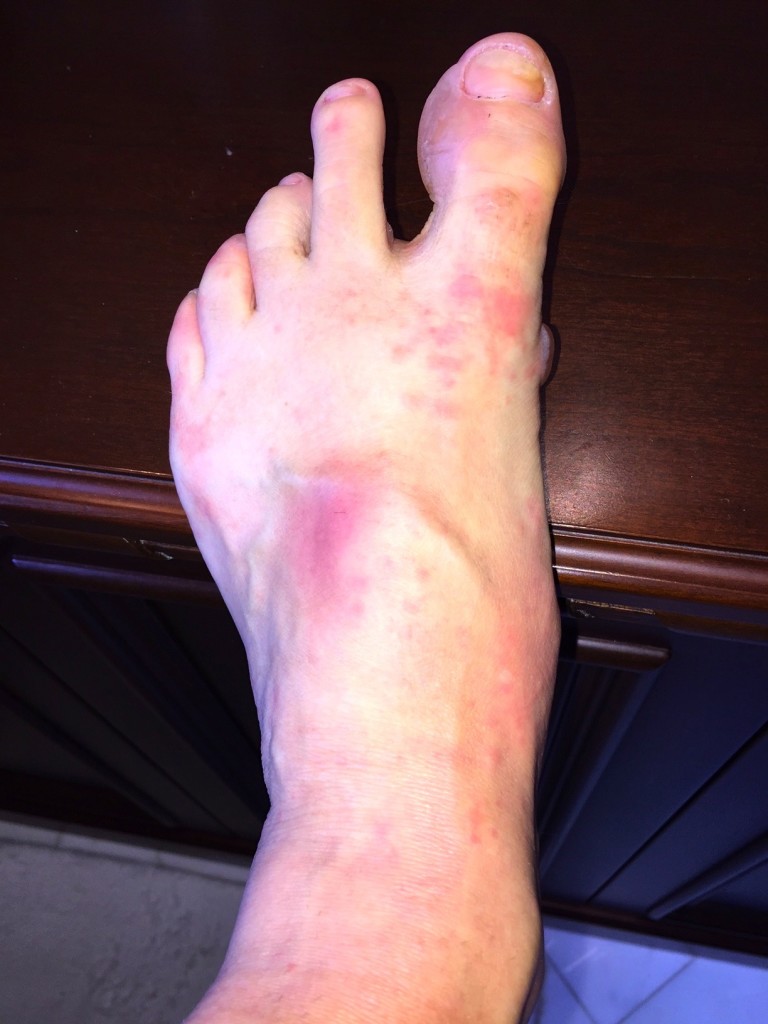
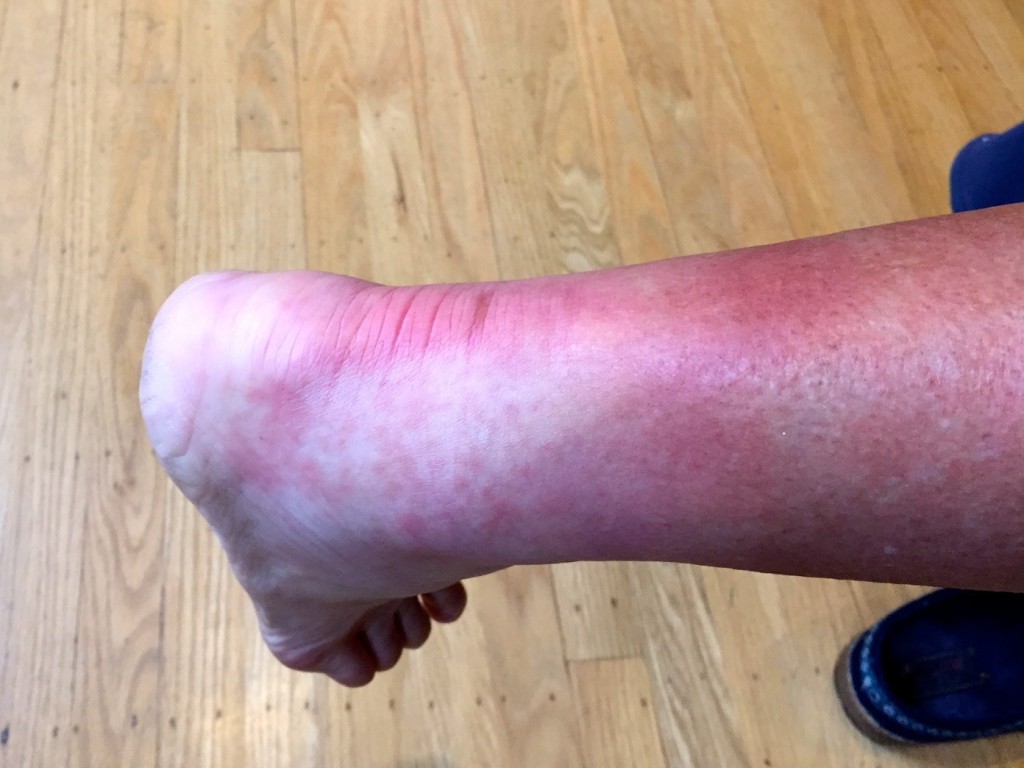
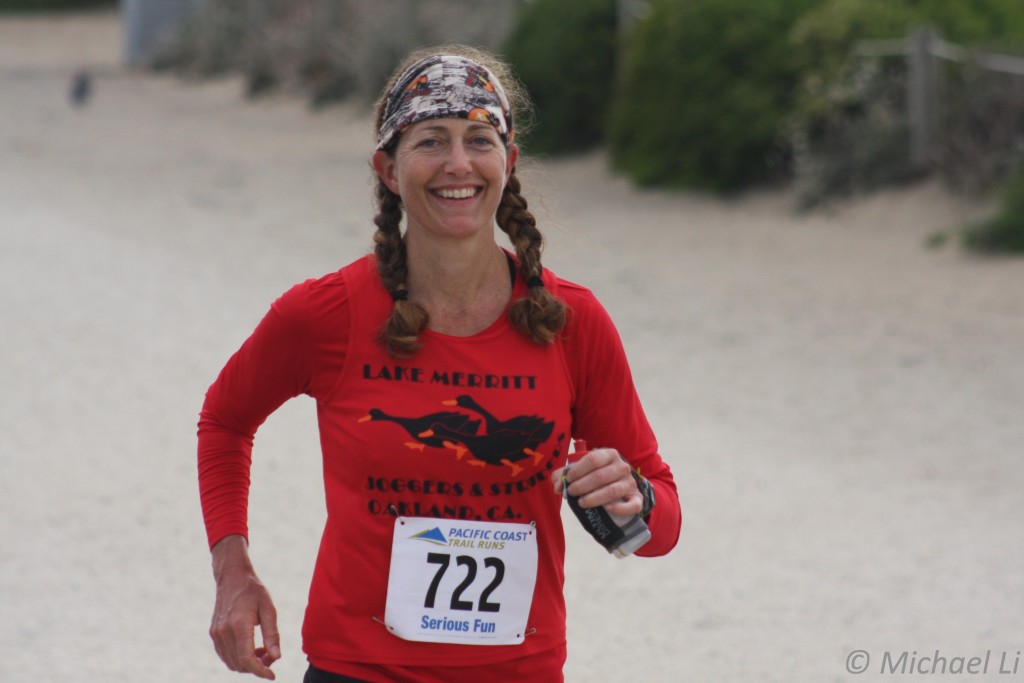
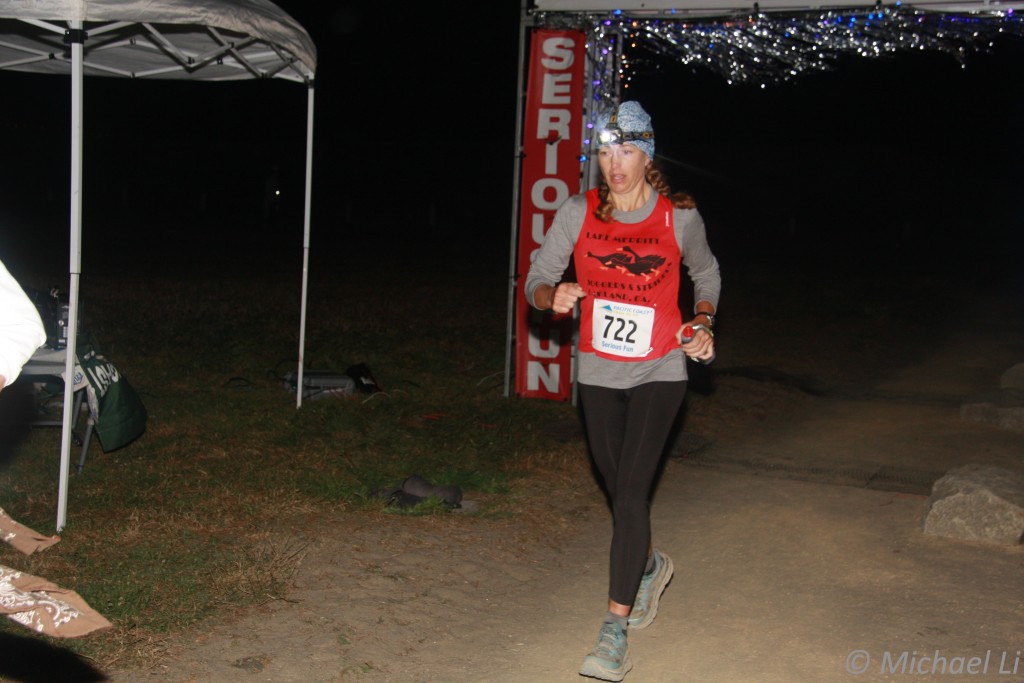
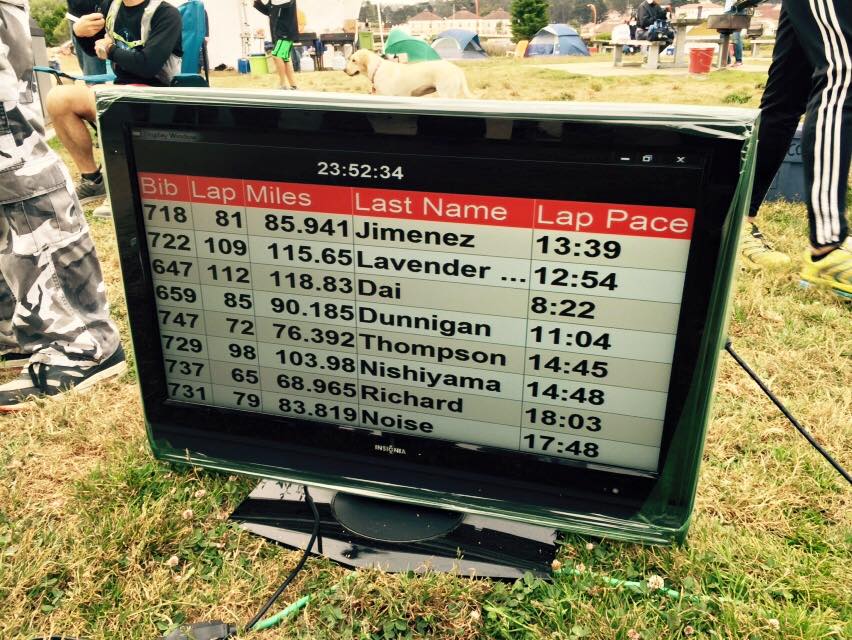
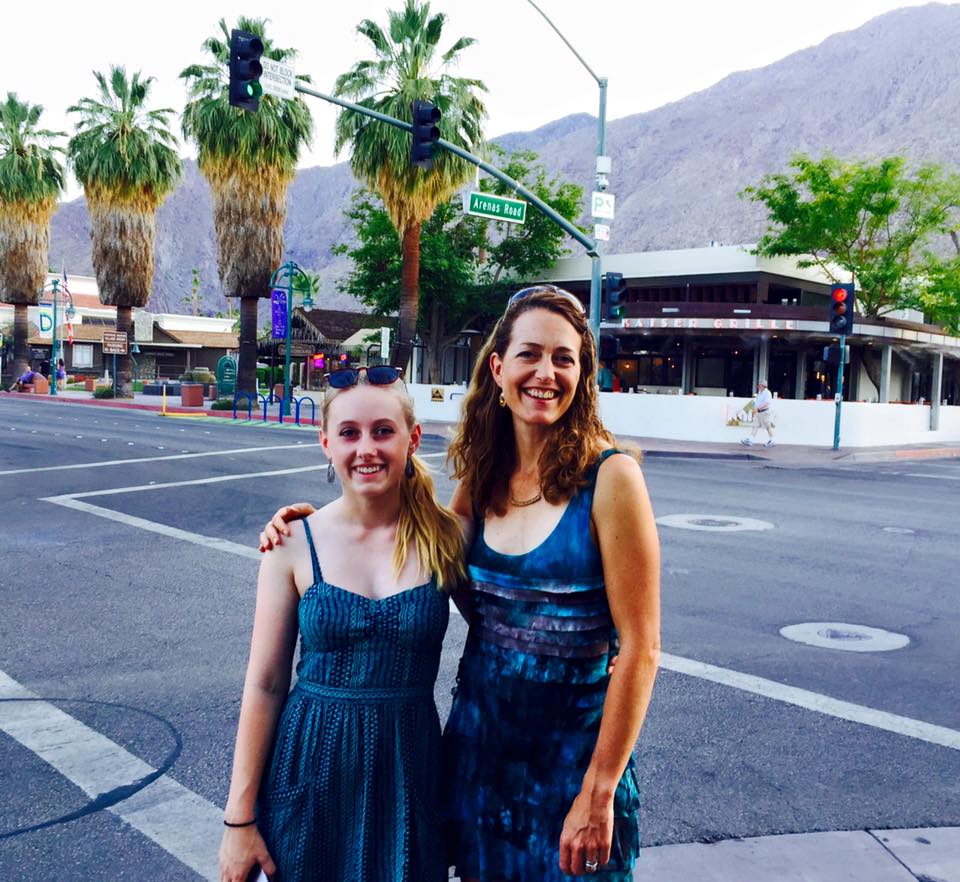
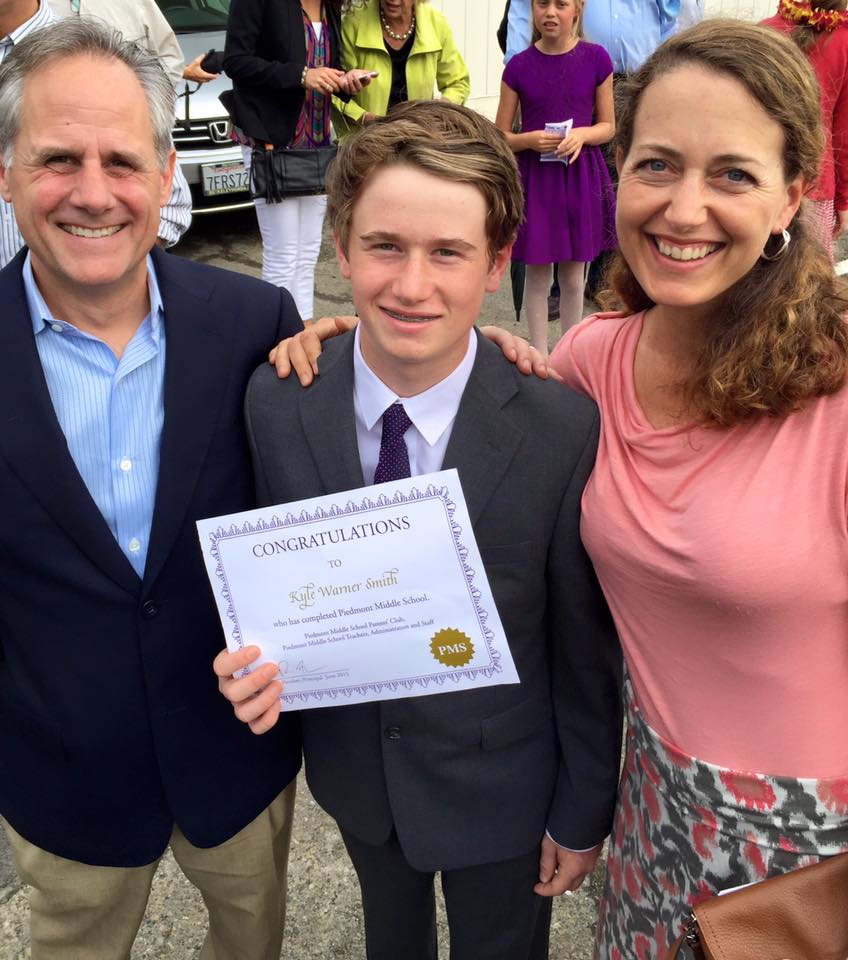
One of your pictures answered a question I had – did you need a headlamp or not? I wasn’t sure how dark it would be on that relatively smooth course.
Way to finish and a HUGE congrats on the win! That’s a great mental challenge. I love that boredom didn’t become an issue – that sure seems like it should be a huge issue.
As far as the right turn thing, the obvious answer is to reverse the direction once in a while, but I suspect that makes for a big challenge for the RD (and I’m sure it’s something that’s been looked into).
You had ONE chance to wear a 100 mile buckle, and you went with a basic loop instead.
Sarah! You did everything right! I guess that’s no surprise. I’m so happy for you! Now you understand what I was talking about: “observing the day in the life of a place” – that’s it exactly!
Congratulations on the win, and racking up an impressive number of miles, and on discovering a new type of ultrarunning. Didn’t I tell you your feet and ankles would get beat up? It’s crazy what repetitive motion can do to you.
To Allen’s question above: You actually DO need a light of some kind because parts of the course get pretty dark, especially when fog obscures the moon and stars.
congratulations Sarah.
Thanks for sharing all your tips for such an event. This type of event is absolutely non-traditional for the distance possibilities. You did fantastic. When I ran that event last year and enjoyed it fully. I also thrashed my feet on those turns. Also, I developed Achilles Tendonitis that lasted 6 months (it did not heal till I forced a two month shutdown for running).
For Allen Lucas: Allen, I used a head lamp out there last year for a few hours. However I had finally decided to run with it OFF for over 4 night hours and glad I did. I was able to enjoy the dim evening and it kinda placed me in a beautiful trance. There was plenty of moonlight and city lights to light the way.
Jesse
WTG Sarah on an amazing accomplishment! Glad I was able to capture snapshots of your journey. Funny to hear about your hallucinations. I had similar experience at Razorback Endurance Race earlier this year and it was quite the trip.
Rest up and all the best to your recovery.
Michael